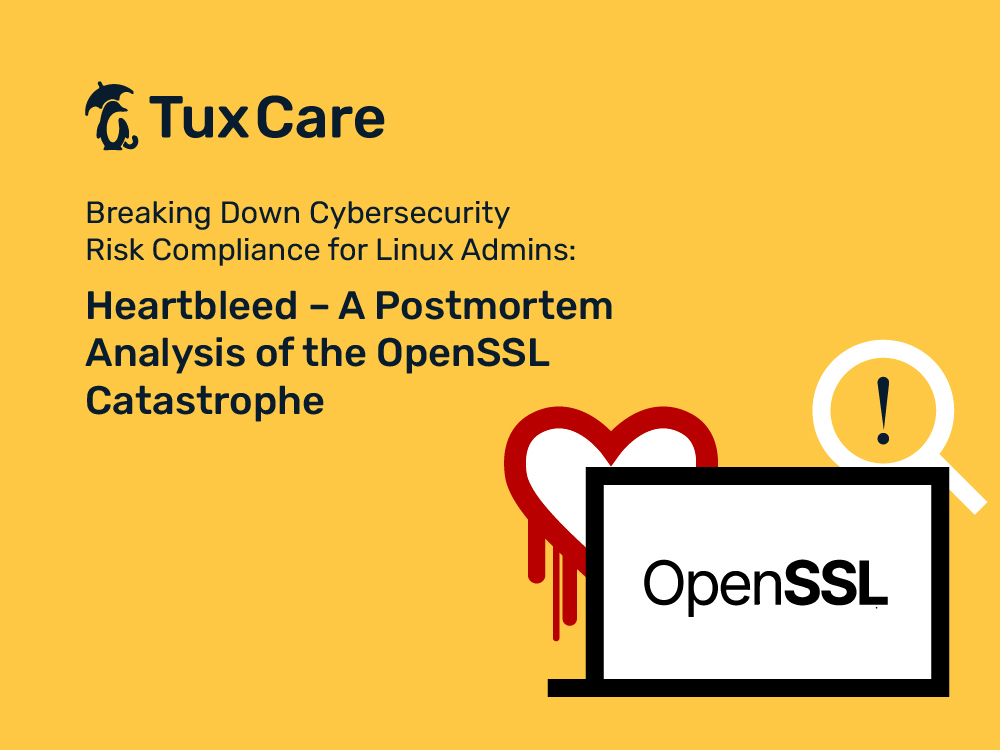Breaking Down Cybersecurity Risk Compliance for Linux Admins: Heartbleed – A Postmortem Analysis of the OpenSSL Catastrophe
In a world growing ever more digitally interconnected, cybersecurity risk compliance has become a top priority for all organizations. This holds especially true for Linux administrators, who often juggle various responsibilities from server maintenance to network security. This article aims to demystify the complex landscape of cybersecurity risk compliance for Linux admins, with a focused postmortem analysis of the infamous Heartbleed bug – a catastrophic vulnerability in the OpenSSL cryptographic software library.
Heartbleed: Exposing the Underbelly of Cybersecurity Compliance
The Heartbleed bug was a severe vulnerability in the OpenSSL library that allowed attackers to read the memory of the host system, effectively exposing critical information like user credentials and private keys. Despite OpenSSL being a widely used security protocol, this weakness went undetected for years, thereby exposing about half a million secure web servers to information theft.
While the Heartbleed incident highlighted the importance of having effective vulnerability management processes in place, it also brought to light the need for comprehensive cybersecurity risk compliance. Today, Linux admins cannot just focus on securing systems, they need to comply with various cybersecurity regulations and frameworks to ensure a robust security posture.
The Pillars of Cybersecurity Risk Compliance
1. Vulnerability Management
Vulnerability management refers to the systematic identification, assessment, and mitigation of vulnerabilities in an IT environment. Effective vulnerability management goes beyond just applying patches and updates. Tools such as OpenVAS and Nexpose can be used to run routine vulnerability scans and assessments, while Ansible can automate the application of necessary patches to the Linux infrastructure.
For example, in the aftermath of the Heartbleed bug, Linux admins had to rapidly identify vulnerable OpenSSL versions, apply the necessary patches, and then regenerate the SSL certificates for their services.
2. Risk Assessment
Risk assessment is the process of identifying and analyzing potential issues that could negatively impact key business initiatives or critical projects. Tools like Risk Register and Resolver allow organizations to identify, assess, and track risks.
In the context of Heartbleed, a risk assessment would involve identifying the systems that used the vulnerable OpenSSL versions, analyzing the potential impact, and then prioritizing mitigation efforts based on the level of risk.
3. Incident Response
Incident response is the approach to handling and managing the aftermath of a security breach or attack (also known as an incident). An incident response plan includes steps to limit damage and reduce recovery time and costs. Tools such as TheHive, a scalable, open-source and free Security Incident Response Platform, can greatly help in coordinating response efforts and improving overall security.
In the Heartbleed scenario, incident response involved identifying the compromise, containing the threat, eradicating the vulnerability, and recovering the systems.
4. Audit & Compliance
Audit and compliance involves assessing whether the organization’s processes and systems align with industry standards and regulations. Tools like Nessus and Lynis can help in auditing the Linux systems for compliance with various standards such as PCI DSS and ISO 27001.
Post Heartbleed, Linux admins had to conduct audits to ensure the vulnerability was completely eradicated and compliance with security standards was maintained.
The Path to Compliance: The Role of Linux Admins
The Linux admin plays a critical role in ensuring cybersecurity risk compliance. They need to be familiar with industry regulations and proficient in using various tools to maintain and verify compliance. Moreover, Linux admins must foster a culture of security within their organizations and promote best practices, such as regular patching and updates, risk assessment, and incident response.
While the Heartbleed vulnerability served as a stark reminder of the perils of unaddressed security vulnerabilities, it also underscored the importance of cybersecurity risk compliance. By understanding the lessons learned from Heartbleed, Linux admins can better safeguard their organizations and ensure resilience in the face of future cybersecurity threats.
In a world where cybersecurity threats are rapidly evolving and increasing in sophistication, the role of the Linux admin in maintaining cybersecurity risk compliance is more important than ever. If you’re a Linux admin or simply interested in learning more about maintaining and enhancing cybersecurity, check out our resources.
For further reading, we recommend the official website of Heartbleed, which provides a comprehensive overview of this vulnerability, its impact, and the steps taken to mitigate it.
In conclusion, cybersecurity risk compliance is not an option, but a necessity. By breaking down its components and learning from past incidents like Heartbleed, Linux admins can ensure they’re well equipped to tackle future cybersecurity challenges head on.
Learning from Heartbleed – Emphasizing Cybersecurity Risk Compliance
The Heartbleed vulnerability served as a wake-up call for many organizations and highlighted the importance of effective cybersecurity risk compliance. The key to preventing similar incidents in the future lies not just in patching known vulnerabilities but also in maintaining a proactive and comprehensive cybersecurity posture that emphasizes constant vigilance, regular assessments, and swift incident response.
By understanding the facets of cybersecurity risk compliance and the role they play in securing an organization’s IT infrastructure, Linux admins can better navigate the challenging and evolving landscape of cybersecurity. Whether it’s identifying and mitigating vulnerabilities or ensuring adherence to compliance standards, the onus is on Linux admins to safeguard their organizations in this ever-evolving digital world.
Many Linux admins opt to secure their OpenSSL libraries with LibCare from TuxCare, which is an add-on for KernelCare Enterprise – a popular live patching tool that delivers security updates without reboots or downtime. With KernelCare and LibCare together, teams can put their CVE patching on autopilot – including for shared libraries – and avoid patch delays or patching-related maintenance operations.
To learn more about KernelCare Enterprise or LibCare, schedule a conversation with a TuxCare Linux security expert.



 Documentation
Documentation Login
Login



